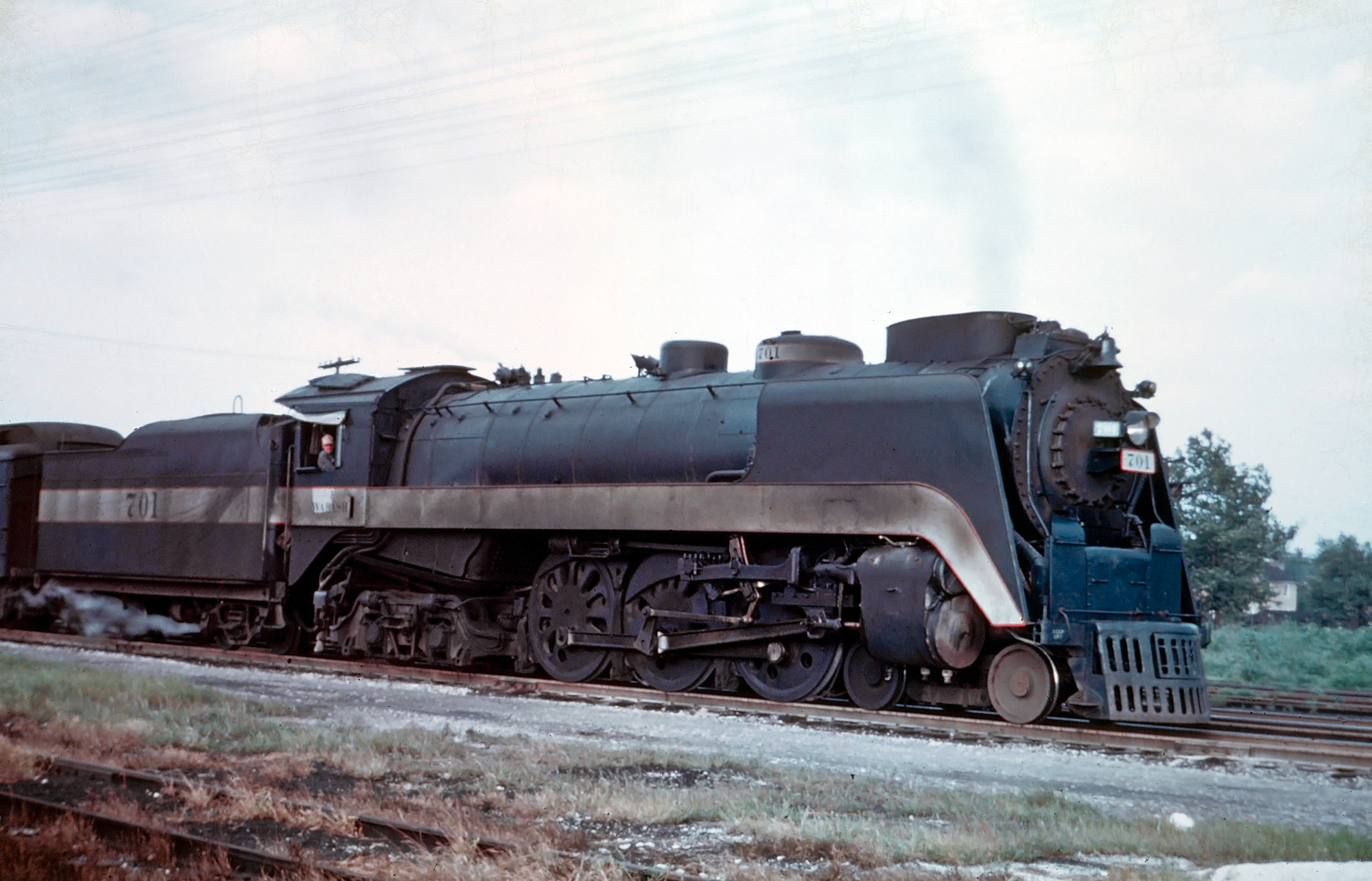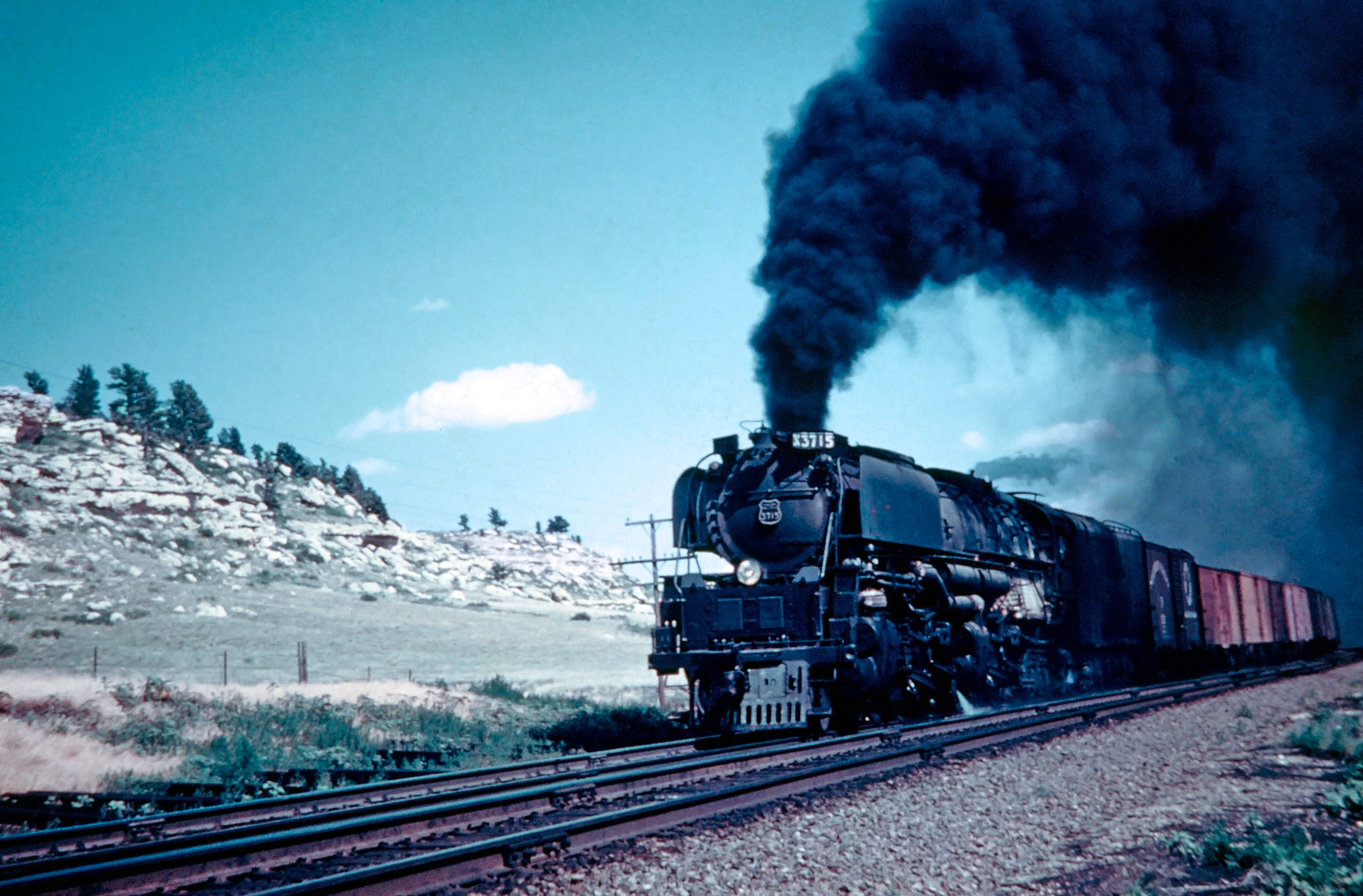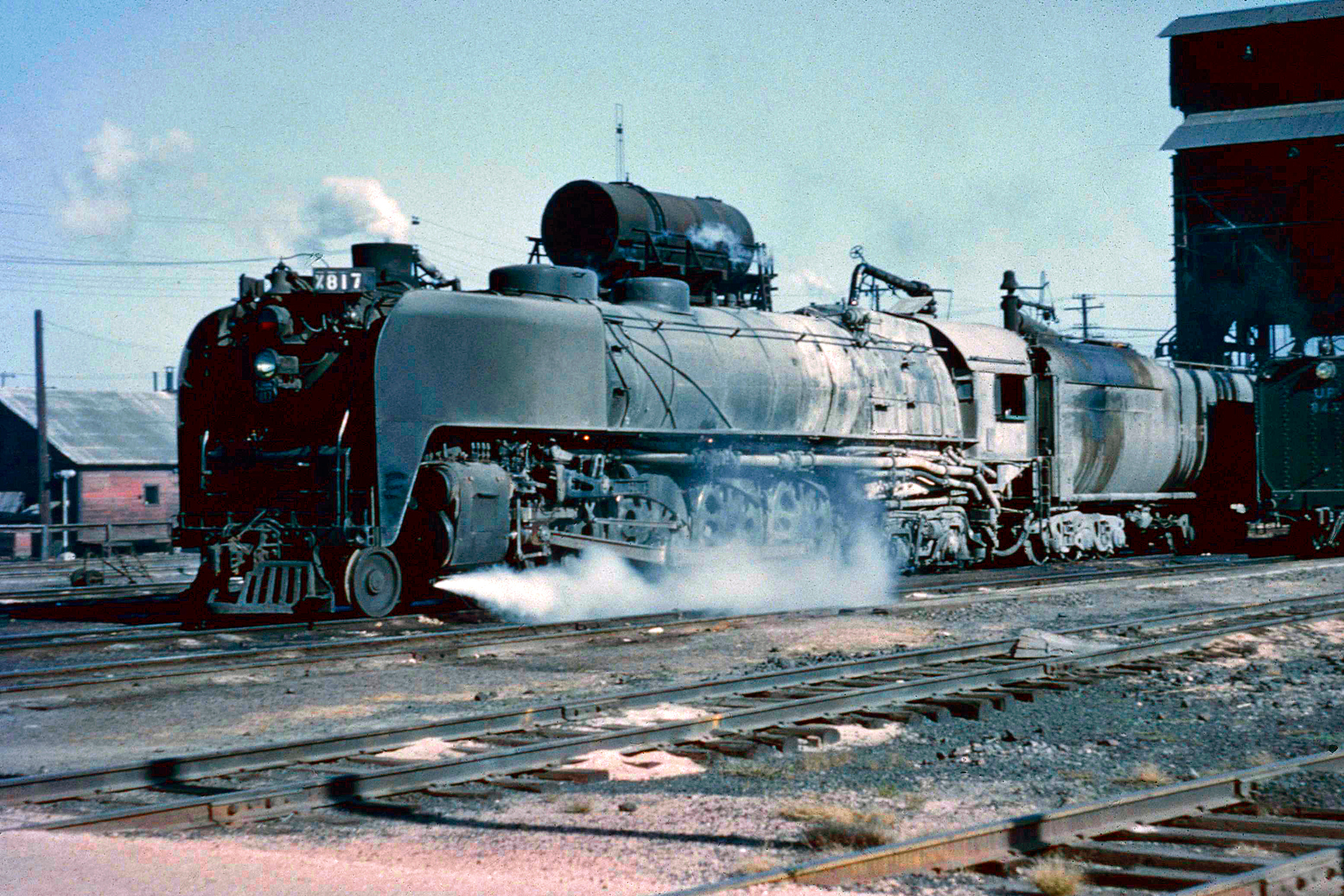Smoke Deflectors: The Classic "Elephant Ears"
Published: August 6, 2024
By: Adam Burns
Smoke deflectors, often whimsically referred to as "elephant ears," are a fascinating feature of steam locomotive design.
These structures, which range from subtle fin-like appendages to large, conspicuous panels, play a crucial role in improving the visibility and operational efficiency of steam engines.
This article delves into the origins, functionality, and variations of smoke deflectors, showcasing their importance in the golden era of steam locomotion.
 A handsome Wabash 4-6-4, #701, is seen here in service at Decatur, Illinois, circa 1954. These Hudsons were rebuilt from 2-8-2s and listed as Class P-1; numbered 700-706, they were semi-streamlined with skirting along the running boards and elephant ears, in addition to receiving a light blue livery with white trim. All were retired by 1956. Fred Byerly photo. American-Rails.com collection.
A handsome Wabash 4-6-4, #701, is seen here in service at Decatur, Illinois, circa 1954. These Hudsons were rebuilt from 2-8-2s and listed as Class P-1; numbered 700-706, they were semi-streamlined with skirting along the running boards and elephant ears, in addition to receiving a light blue livery with white trim. All were retired by 1956. Fred Byerly photo. American-Rails.com collection.Origins and Development
During the height of the steam locomotive era in the late 19th and early 20th centuries, engineers continually sought to optimize the performance and safety of their engines. One recurring challenge was the management of smoke and steam, which could severely hinder the crew's visibility. As locomotives became faster and more powerful, these plumes became denser and more pronounced, posing a significant operational risk.
German engineers first tackled this issue in a systematic way in the 1920s. The Deutsche Bundesbahn, or DB (German Federal Railway), was among the pioneers, introducing Witte and Wagner smoke deflectors on their locomotives. These early designs consisted of large metal plates mounted on either side of the smokebox, extending forward to catch and redirect the smoke.
Functionality
The primary function of smoke deflectors is to improve the crew's visibility by managing the flow of smoke and steam from the locomotive's chimney.
As the train moves, air pressure builds up in front of the locomotive, causing smoke and steam to billow backwards, potentially obstructing the view from the cab. Smoke deflectors counteract this by creating an aerodynamic barrier.
As the locomotive travels, the deflectors channel the airflow around the smokebox, essentially pushing the plumes of smoke upward and away from the engine. This redirection of smoke not only enhances the engineer's line of sight but also reduces the accumulation of soot and grime on the windshields and other components, contributing to the overall efficiency and cleanliness of the locomotive.
Variations in Design
Smoke deflectors come in various shapes and sizes, adapting to the specific needs of each locomotive and its operating environment. Here are some notable designs:
1. **Witte Smoke Deflectors**: Named after their designer, Witte deflectors are characterized by their smaller and more streamlined shape. These deflectors were an improvement over earlier, bulkier designs and became standard on many German locomotives.
2. **Wagner Smoke Deflectors**: Another German innovation, Wagner deflectors are larger and more rectangular than the Witte type. They are typically mounted further forward on the locomotive, providing a more pronounced barrier against smoke.
3. **British "Pony Ears"**: In the UK, smoke deflectors were often colloquially referred to as "pony ears" due to their smaller size compared to their German counterparts. British railways employed these deflectors on various locomotives, including the famous Peppercorn A1 and A2 Pacifics.
4. **American Usage**: While less common in the United States, some American locomotives also featured smoke deflectors - commonly known as elephant ears in the U.S. Notably, the Big Boy, Challenger, and Northern classes were equipped with these devices to manage the massive volumes of smoke produced by their enormous boilers.
 Union Pacific 4-6-6-4 #3715 is seen here in service near Potter, Nebraska, circa 1955. Richard Wallin photo. American-Rails.com collection.
Union Pacific 4-6-6-4 #3715 is seen here in service near Potter, Nebraska, circa 1955. Richard Wallin photo. American-Rails.com collection.Case Studies
Several iconic steam locomotives are renowned for their use of smoke deflectors. Let's explore a few examples:
**1. Deutsche Reichsbahn Class 01**
The German Class 01 Pacifics, introduced in the 1920s, were among the first to sport smoke deflectors. Originally equipped with Wagner deflectors, many were later retrofitted with the more efficient Witte design. These locomotives became the workhorses of the German rail network and are often featured in historical films and exhibitions.
**2. LNER Class A1 and A3 Pacifics**
Perhaps the most famous example of British locomotives with smoke deflectors is the London and North Western Railway's Class A1 and A3 4-6-2s, designed by Sir Nigel Gresley. Their deflectors - added during a later rebuilt - were crucial for maintaining visibility at high speeds, allowing the locomotives to achieve their remarkable performance.
Initially introduced to serve main line passenger routes, these locomotives later excelled in express passenger services. Originally designed for the Great Northern Railway (GNR), they became a hallmark of the LNER following the 1923 amalgamation.
The transition from Class A1 to A3 denoted a significant upgrade: the incorporation of a higher pressure boiler with an enhanced superheating surface, alongside a slight reduction in cylinder diameter.
This modification resulted in increased locomotive weight and improved performance. Eventually, all A1 locomotives were rebuilt, with most being upgraded to A3 specifications. Notably, locomotive No. 4470 underwent a complete transformation, emerging as a unique Class A1/1.
**3. Union Pacific Big Boy**
The Union Pacific Big Boy, the largest and heaviest steam locomotive ever built, also utilized smoke deflectors. These colossal engines operated in the mountainous regions of the American West, where managing smoke was essential for safe operation through tunnels and steep grades. The smoke deflectors were uncommon but were added on some Big Boys to help ensure the crew had a clear view ahead, even under demanding conditions.
**4. Union Pacific Challengers and Northerns**
Elephant ears were most prevelant and effective on UP's 4-6-6-4s and 4-8-4s, which typically operated at high speed in either freight or passenger service.
Introduced in the mid-1930s, the articulated 4-6-6-4s were designed to tackle the demanding gradients and expansive routes of the American West.
With a 4-6-6-4 wheel arrangement, the Challengers combined the power of two engine sets on a single frame, a design that allowed them to deliver exceptional tractive effort while maintaining speed.
Engineered primarily for freight service, the Challengers were versatile enough to haul passenger trains, proving their adaptability and strength. They were equipped with large boilers and efficient exhaust systems which facilitated sustained high-speed travel and heavy hauling capabilities.
Over the years, the Challengers underwent multiple improvements, including advancements in boiler pressure and refinements in design to enhance performance and fuel efficiency.
Union Pacific's Challenger locomotives became a backbone of the railroad's operations, deftly managing the steep grades and long runs typical of western terrains.
Among these behemoths, locomotive No. 3985 gained fame as one of the last operating steam engines, preserved and celebrated by rail enthusiasts around the world. The enduring legacy of the 4-6-6-4 Challengers continues to captivate those fascinated by the golden age of steam.
Union Pacific's 4-8-4 steam locomotives, known as the "Northern" class, were a blend of power and speed designed for heavy-duty passenger and freight services. Introduced in the late 1930s, these locomotives featured a 4-8-4 wheel arrangement, providing stability and improved traction.
Equipped with large boilers and robust driving mechanisms, the 4-8-4s could haul long trains over vast distances with remarkable efficiency.
Among them, the famous "844" continues to operate, serving as a moving testament to the era of steam. These engines epitomize Union Pacific's commitment to innovation and excellence in rail transportation.
Impact on Locomotive Design and Operations
The introduction of smoke deflectors represented a significant advancement in steam locomotive design. By improving visibility and reducing soot accumulation, these devices contributed to safer and more efficient operations. Engineers could maintain higher speeds with greater confidence, knowing that their line of sight would remain unobstructed.
Moreover, the effectiveness of smoke deflectors allowed locomotives to operate more reliably in challenging environments, such as mountainous regions and dense urban areas. This adaptability was crucial in an era when railways were the backbone of transportation and commerce.
Legacy and Preservation
As steam locomotives gradually gave way to diesel and electric technology, the need for smoke deflectors diminished. However, the legacy of these ingenious devices lives on in preserved steam locomotives and heritage railways around the world.
Enthusiasts and historians continue to celebrate the engineering marvels of the steam era, often showcasing locomotives with their original smoke deflectors intact. These preserved engines offer a tangible link to the past, allowing future generations to appreciate the ingenuity and craftsmanship of early railway engineers.
 Union Pacific 4-8-4 #817 is serviced in Council Bluffs, Iowa during the 1950s. American-Rails.com collection.
Union Pacific 4-8-4 #817 is serviced in Council Bluffs, Iowa during the 1950s. American-Rails.com collection.Conclusion
Elephant ears are a testament to the innovative spirit of the steam locomotive era. These simple yet effective devices played a vital role in enhancing visibility, safety, and operational efficiency, ensuring that steam locomotives could continue to meet the demands of a rapidly changing world.
From the renowned Class 01 Pacifics of Germany to the powerful Big Boys of Union Pacific, smoke deflectors remain a symbol of the elegance and functionality that defined the golden age of steam.
Recent Articles
-
Connecticut Christmas Train Rides In Essex!
Dec 19, 25 04:55 PM
While spring through fall bring daily excursions and seasonal special events at the Essex Steam Train, it’s the North Pole Express—its signature holiday journey—that has become a treasured tradition f… -
Colorado Christmas Train Rides In Georgetown!
Dec 19, 25 04:35 PM
The Georgetown Loop Railroad, a historic narrow-gauge line high in Colorado’s Rockies, firmly belongs in the latter category—especially during its Christmas season rides. -
North Carolina's "Whiskey" Train Rides
Dec 19, 25 04:30 PM
This article will delve into the charm of these whiskey train rides, their offerings, historical context, and why they deserve a spot on your travel itinerary.



